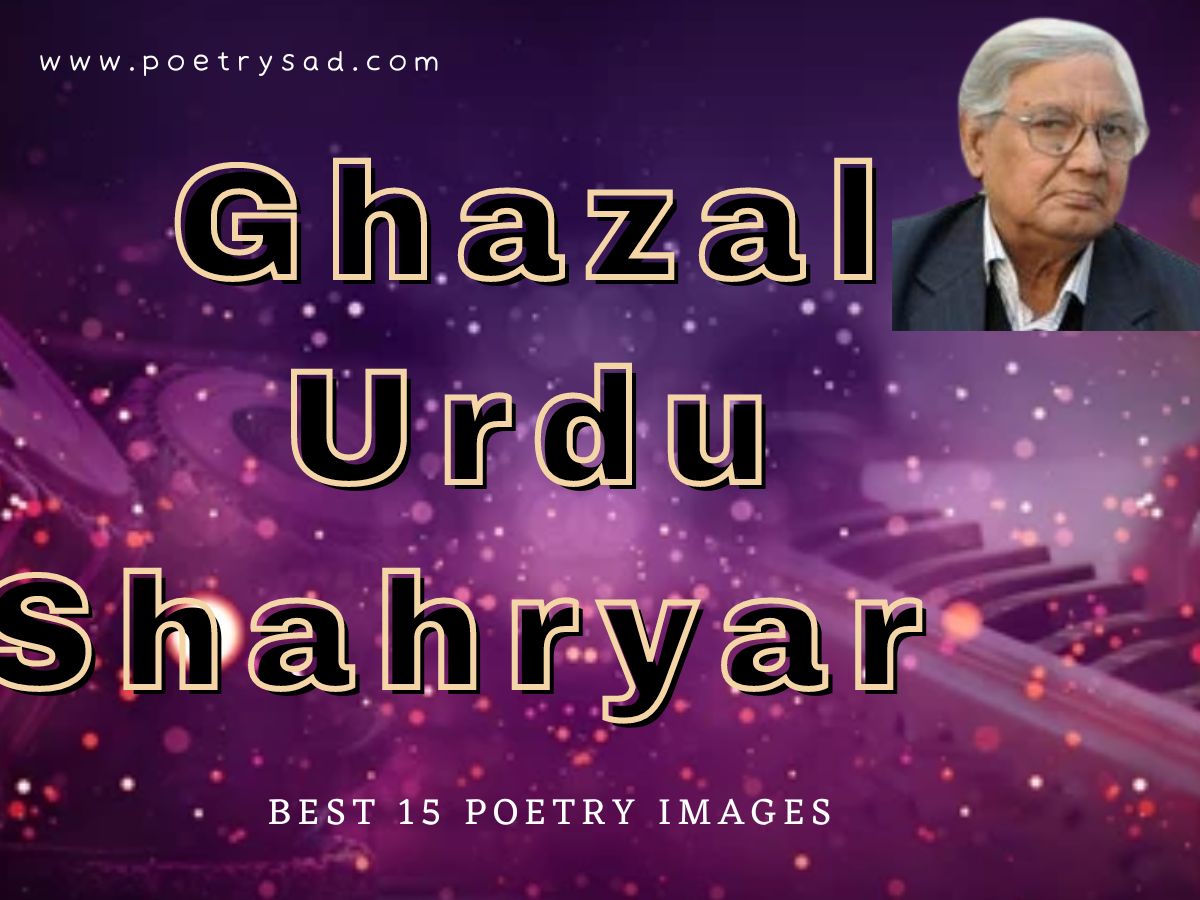Ghazal urdu shahryar is a timeless art form that combines poetry and music. In this post, we will go on a melodic journey, exploring the complexities and beauty that constitute Ghazal Shahryar.

خوابوں کے باغ میں جہاں سائے نرمی سے کھیلتے ہیں
رات کی سرگوشیاں، دن نکلنے تک کہانیاں بُنتی رہتی ہیں۔
چاندنی آسمان کے کینوس پر اپنے راز بکھیرتی ہے
ایک آسمانی رقص، جہاں خواہشات اڑنا سیکھتی ہیں۔
تیرا نام، ایک راگ، خاموشی میں گونجتا ہے،
ایک محبت کی بازگشت، جو میرے دل میں بہت زیادہ ہے۔
وقت کی راہداریوں میں جہاں یادیں رہتی ہیں
ہمارے لمحوں کی خوشبو، ہر قدم پر، میں قدم بڑھاتا ہوں۔
آرزو کی تپش میں تیری غیر موجودگی نشان چھوڑتی ہے
اندھیرے کی خاموشی میں آنسوؤں کی سمفنی۔
اے شہریار شاعر عشق تیرے اشعار اب بھی کھلتے ہیں
جذبے کی ایک لازوال کہانی، ہر لفظ میں جو آپ نے بتائی ہے۔
جذبات کے دائرے میں، جہاں آیات نرمی سے آہیں بھرتی ہیں،
دل کی غزل، چاندنی آسمان کے نیچے۔
Q1: Who is Shahryar, and what is he known for?
Shahryar is a prominent Persian poet who made substantial contributions to modern Persian literature. Seyyed Mohammad Hossein Behjat-Tabrizi was born in Iran in 1906 and went by the pen name Shahryar, which means “king of poets.” His poetry is notable for its deep philosophical concerns, love, and social consciousness. Shahryar’s works reflect the turbulent sociopolitical scene of his time, which included the Constitutional Revolution and subsequent events that formed Iran. One of his best-known works is the epic poem “Heydar Baba,” which combines folklore, mythology, and social satire. Shahryar’s lyrical and emotive style has established him as a key figure in Persian literature.
Q2: Who is Shahryar in the Mughal Empire?
Ans: There is no notable historical figure named Shahryar affiliated with the Mughal Empire. It’s possible that you’re thinking about a fictitious character or a lesser-known historical figure. The Mughal Empire, which governed South Asia from the 16th to the 19th centuries, was led by rulers including Babur, Akbar, Shah Jahan, and Aurangzeb, among others.If you have any other information or context about the Shahryar you are referring to in the Mughal Empire, I would be pleased to help supply it or clarify further. Otherwise, there may be some uncertainty about names or historical periods.
Q3: What is Shahryar’s full name?
Ans: Shahryar’s full name is Seyyed Mohammad Hossein Behjat-Tabrizi. He took the pen name “Shahryar,” which translates as “king of poets.” Shahryar, a famous Persian poet born in 1906 in Iran, made significant contributions to modern Persian literature.
More Related Articles
The Origins: Tracing the Roots of Ghazal Shahryar
Ghazal Shahryar has a strong foundation in Persian and Urdu literature. Discover the rich history and cultural significance that influenced this artistic expression.
Poetic Tapestry: Understanding the Craft
1. Rhyme and rhythm: creating harmony in words,
Ghazal urdu shahryar is recognized for its elaborate rhyme schemes and rhythmic patterns. Discover how poets combine words to create a harmonic flow.
2. Themes and Emotions: A Variety of Feelings
Explore Ghazal Shahryar’s numerous topics, which range from love and heartbreak to mysticism. Unravel the emotions contained in each verse.
Maestros of Ghazal Shahryar
3. Jagjit Singh, the Ghazal King.
Explore Jagjit Singh’s legacy as a maestro who took Ghazal Shahryar to new heights with his soul-stirring performances.
4. Farida Khanum: A Voice That Resounds
Discover the lovely voice of Farida Khanum, whose contributions have left an indelible impression on Ghazal Shahryar.
Ghazal Shahryar crosses borders.
5. Global Influence: Beyond Cultural Boundaries.
Witness how Ghazal Urdu Shahryar has crossed geographical boundaries, capturing hearts all across the world.
The Evolution of Ghazal Shahryar in Contemporary Times
6. Fusion and Modern Music: Bridging Traditions
Investigate the combination of Ghazal Shahryar and current music, resulting in a distinct sound that appeals to a wide range of audiences.
Perplexity and Burstiness: The Art of Keeping It Interesting.
7. Creating Intriguing Stories: Balancing Perplexity
Unravel the significance of bewilderment in Ghazal Shahryar, engaging the audience with layers of meaning and complexity.
8. Burstiness in Expression: A Dynamic Approach
Understand how burstiness lends dynamism to Ghazal Shahryar’s lyrical statements by putting energy into them.
Creating Ghazal Shahryar Content: A Balanced Act
9. Maintaining Specificity: Navigating the Details
Explore the difficult balance between burstiness and specificity to ensure content richness without sacrificing context.
10. The Formal “We”: Engaging with the Audience
Engage the audience with formal “we” language to foster a sense of shared experience and connection.
A Conversational Journey: Connecting with Readers.
11. “Keeping It Simple: The Power of Simplicity”
Accept simplicity in language, making Ghazal Shahryar approachable and entertaining to readers from all backgrounds.
12. Active Voice: Putting Energy into Words
Use the active voice to add vitality to the tale and captivate the listener with a sense of urgency.
13. Rhetorical Questions: Prompting Reflection
Pose thought-provoking questions, encouraging readers to consider the complex ideas present in Ghazal Shahryar.
14. Analogies and Metaphors: Painting Vivid Images.
Use analogies and metaphors to create a vivid image and strengthen the reader’s connection to the emotions expressed in Ghazal Shahryar.
Conclusion:
Shayari concludes that Ghazal Shahryar is a timeless art style that continues to amaze and resonate across civilizations. As we say goodbye to this musical voyage, let the echoes of its poetry stay in our hearts.
FAQs:
Q1: What constitutes Ghazal Shahryar?
Ans: Ghazal. Shahryar is a literary and musical genre derived from Persian and Urdu literature, distinguished for elaborate rhyme systems and profound emotional topics.
Q2: Who are some famous Ghazal Shahryar artists?
Ans: Jagjit Singh and Farida Khanum are well-known maestros who helped Ghazal Shahryar gain prominence.
Q3: How has Ghazal Shahryar changed over time?
Ans: The art form has progressed by incorporating current influences and blending classic Ghazal features with contemporary musical genres.
Q4: Why does burstiness matter in Ghazal Shahryar?
Ans: Burstiness injects vibrancy and energy into lyrical language, keeping the listener interested and enthralled.
Q5: Can Ghazal Shahryar cross cultural boundaries?
Ans: Yes, Ghazal Shahryar has a global appeal, engaging audiences across cultural boundaries with universal themes of love, mysticism, and emotions.
